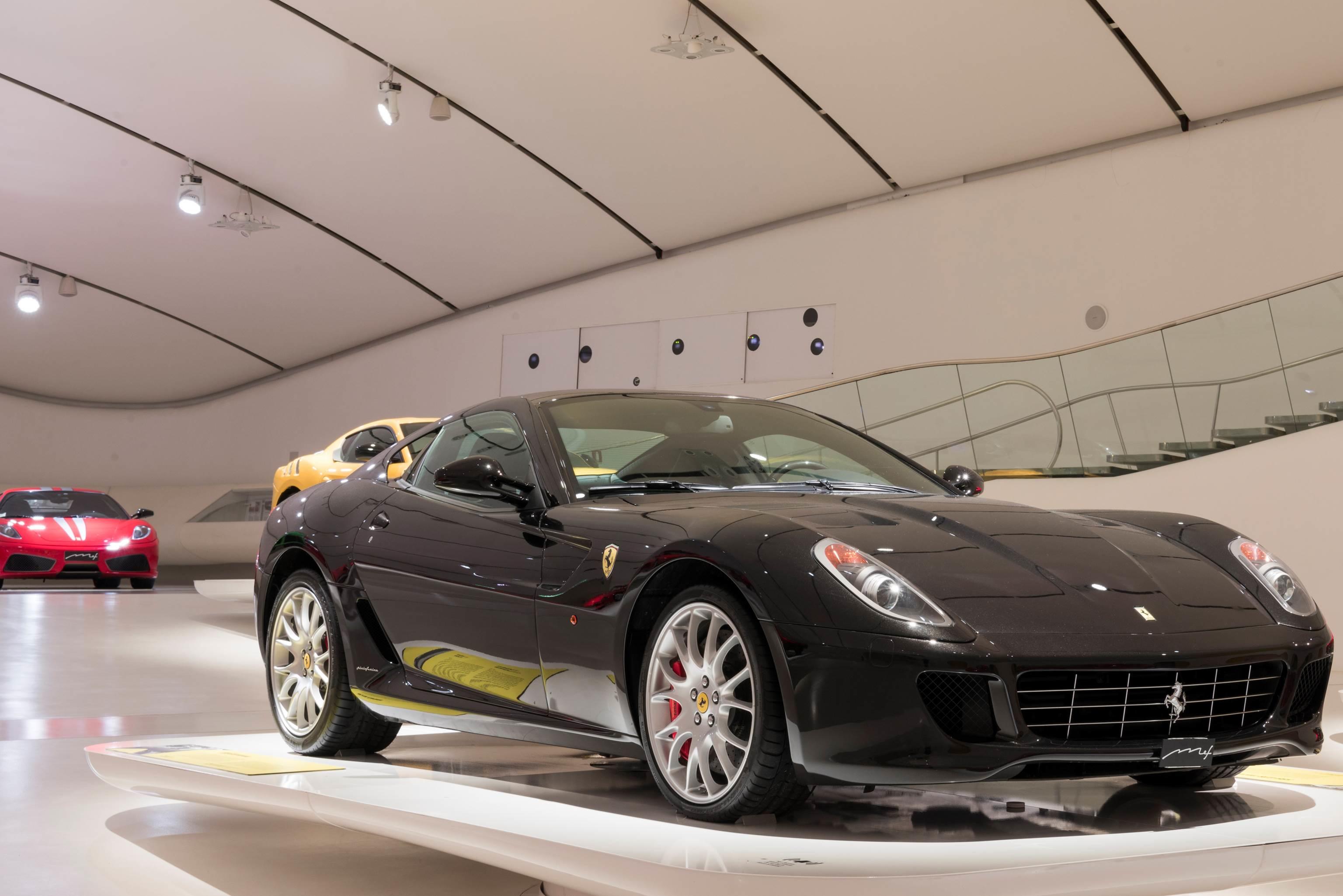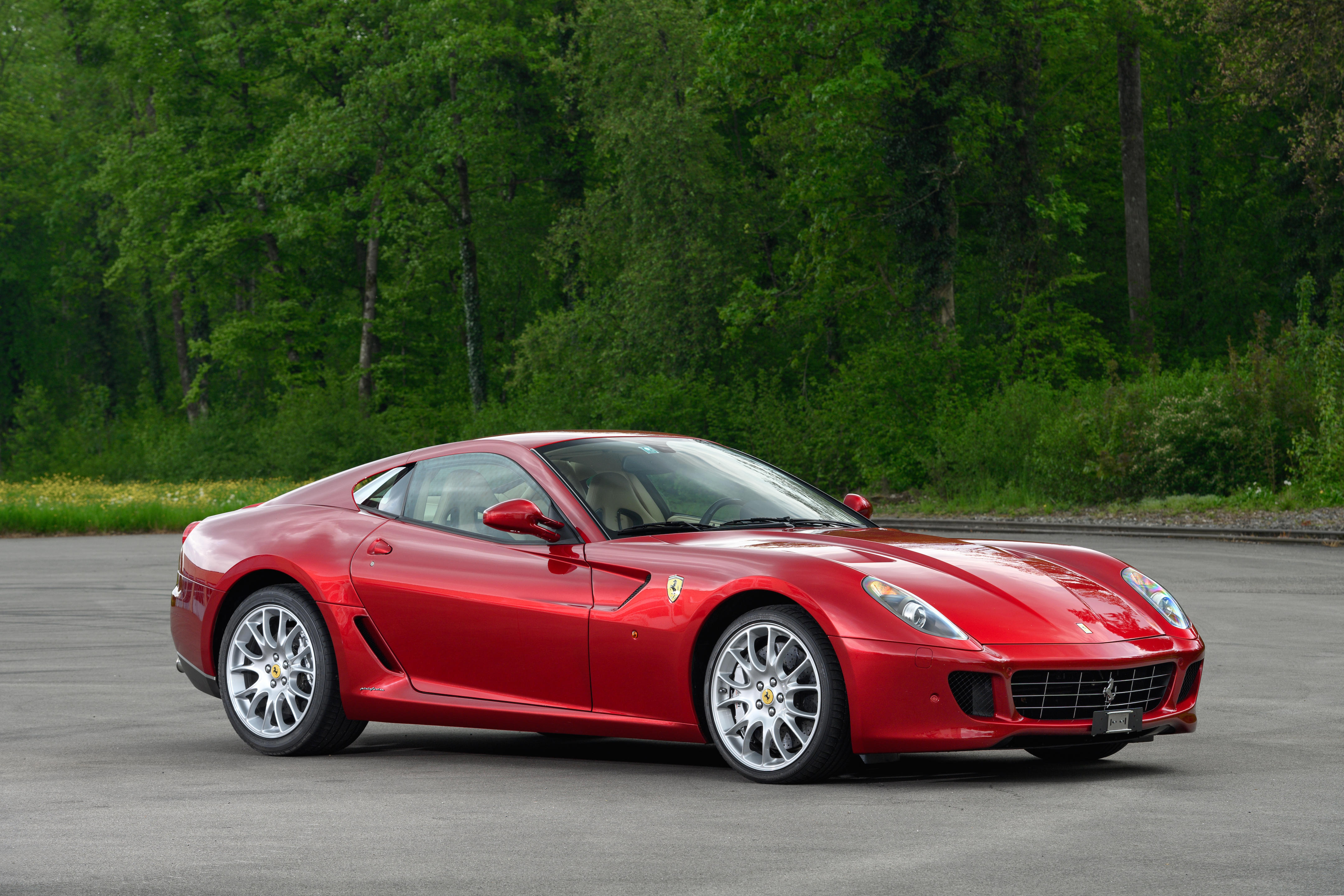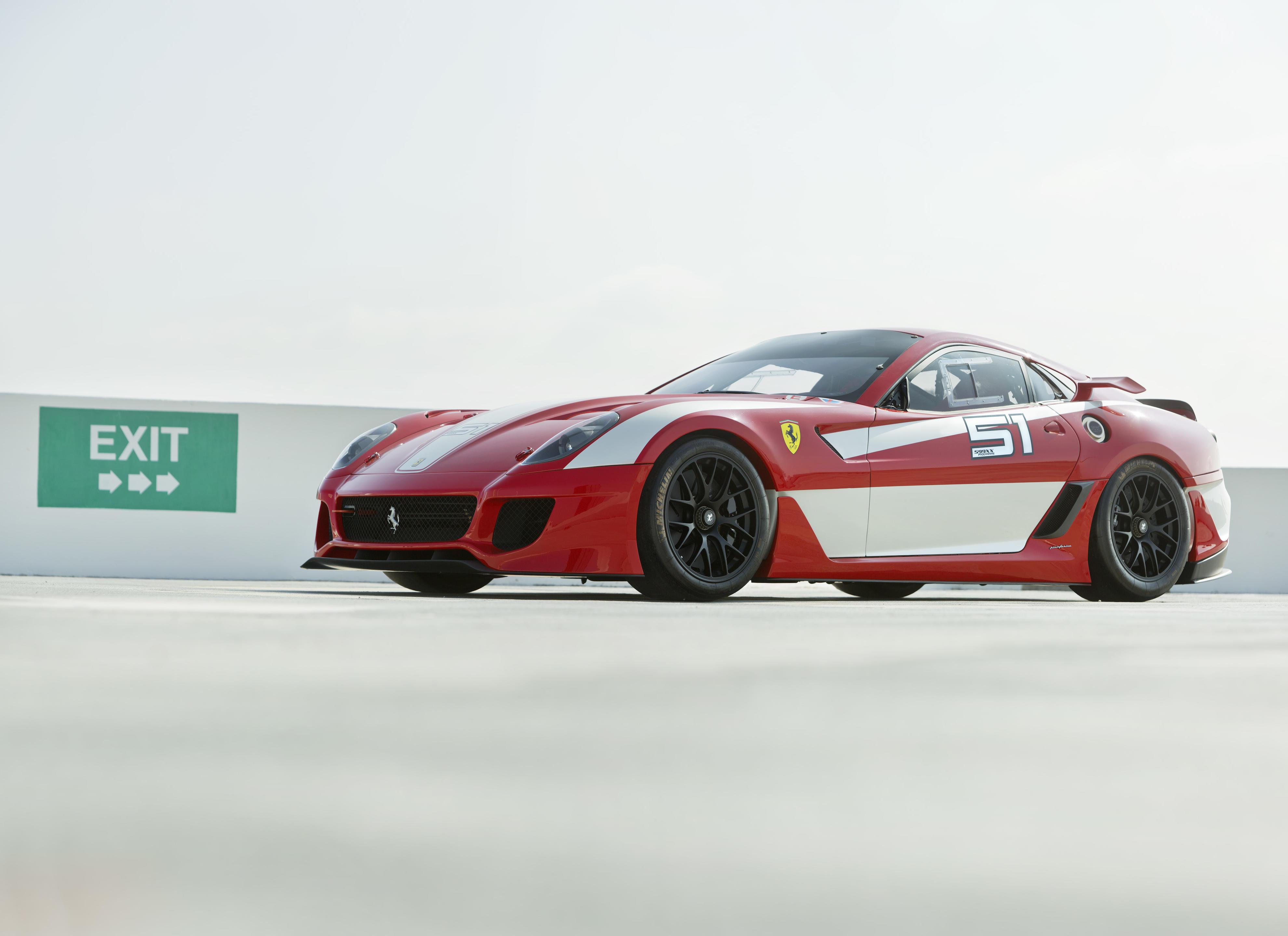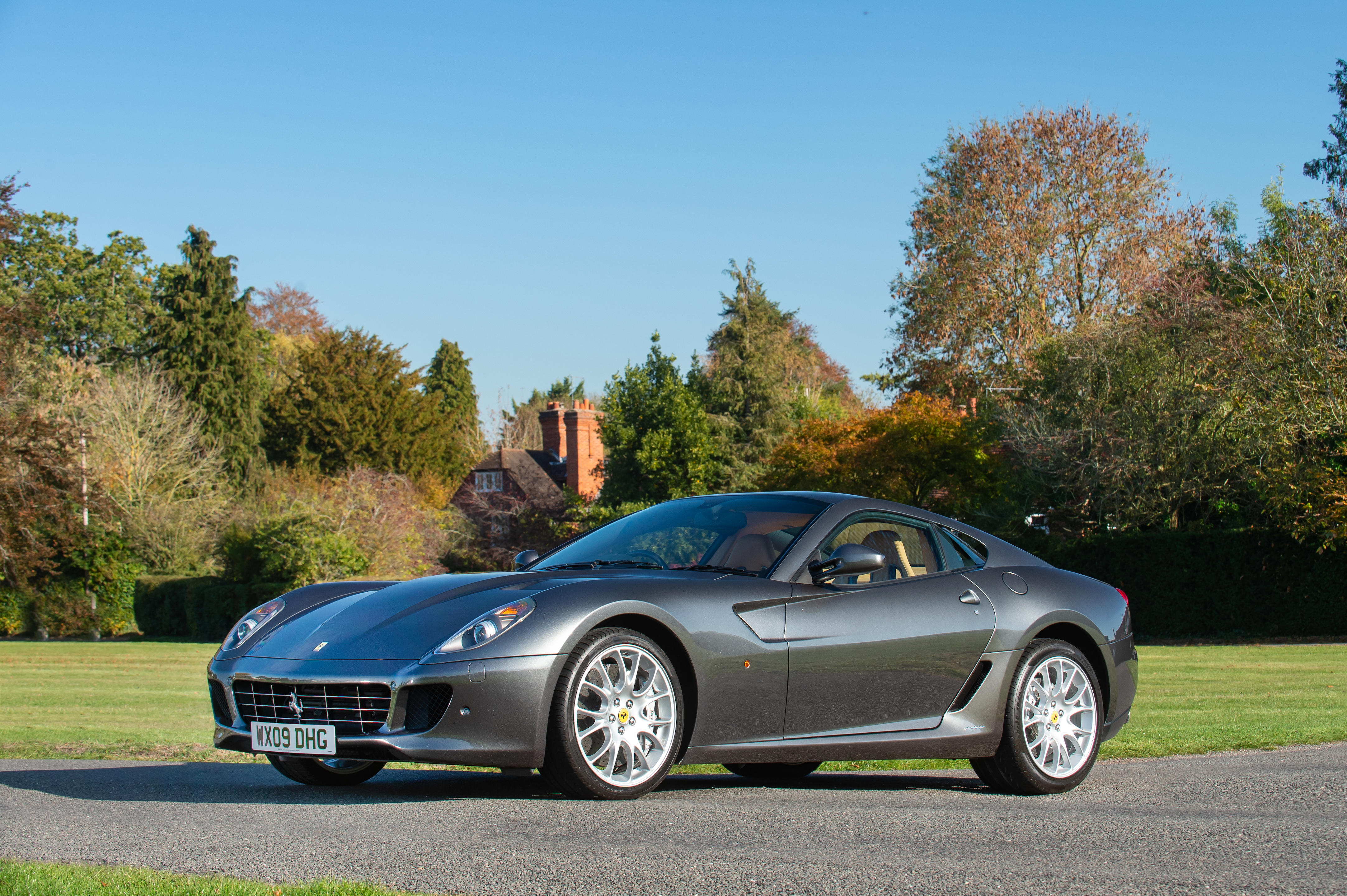2009 Ferrari 599 GTB Fiorano Coupé Coachwork by Pininfarina Chassis no. ZFFFD60B000170353 •Exclusive Ferrari supercar •Sold new in France •First service at 2,428km •2,492km recorded •All books available Fußnoten "The Ferrari 599 offers mind-blowing pace and handling. Quite possibly the best Ferrari of its generation. We'll spare the 911 Turbo the ignominy of comparison times, because the Ferrari has moved the game onto another level. "There are the quick cars – those that nip below 10 seconds to 100mph, such as the Lamborghini Gallardo. Then there are the very quick cars, which post 0-100mph times beginning with an eight. But anything under eight seconds belongs to an elite group, and in gaining such membership, the Ferrari 599 has shaken the establishment like nothing in the past 20 years. Its 7.4sec average matches the time we recorded for the Pagani Zonda S. Rest to 60mph takes just 3.7sec." – Autocar. Introduced at the Geneva Motor Show in February 2006, the 599 GTB Fiorano took its name from Ferrari's famous test track and was the latest in a succession of models named after places associated with the marque such as Modena and Maranello. Its immediate predecessor - the 575 Maranello - had met with a mixed reception, disappointing those that had so admired the 550 Maranello, so Ferrari had some catching up to do in designing the 599. Having favoured the mid-engined layout for its 12-cylinder road cars from the mid-1970s to the late 1990s, Ferrari surprised everyone by introducing the 550 Maranello. The latter's arrival in 1997 saw the Italian manufacturer return to its tradition of building front-engined V12 two-seater sports cars, resurrecting a line that had remained dormant since the demise of the 365GTB/4 'Daytona' in 1974. The 599 was the latest in this noble line that stretched all the way back to the 250GT SWB of the early 1960s. In designing the 599, Ferrari abandoned the tubular steel chassis of the 550/575, adopting a more advanced and lighter all-aluminium chassis of greatly increased stiffness. Styled by Pininfarina under the direction of Ferrari's Frank Stephenson, the 599 with its long bonnet, small cabin, raised haunches and aggressive stance seemed the very definition of the term 'sports car'. The body's aerodynamics were developed in the wind tunnel, where hours of testing ensured that the minimum of drag was combined with constant downforce regardless of set up, an important consideration in a 200mph road car. Styling details such as the front brake ducts and hot air outlets behind the front wheelarches recalled the great competizione Ferraris of the past while the tail incorporated Ferrari's characteristic twin circular lights. The heart of any Ferrari is its engine, and the 599's 48-valve, 6.0-litre V12 was a reworked version of that found in the Enzo supercar. As installed in the 599, this state-of-the-art unit produced a staggering 612bhp at 7,600rpm with maximum torque of 448lb/ft at 5,600 revs. Weighing a claimed 1,690kg, the 599 has a power-to-weight ratio of 362bhp per tonne, far eclipsing the 291bhp/tonne of its 575 Maranello predecessor. Developed as part of Ferrari's Formula 1 programme, the paddle shift gearbox had become a feature of its range-topping sports cars and was available in its latest form for the 599, capable of changing gear in a mere 100 milliseconds. A conventional six-speed gearbox was available also. Although active suspension had long been banned form Formula 1, its development for road cars had continued and the 599 came equipped with SCM magnetorheological 'semi-active' dampers. The latter's damping fluid changes in viscosity almost instantaneously when a magnetic field is applied, thereby altering the suspension characteristics. Damper controls were placed on the Formula 1-style steering wheel together with those for traction control and stability, as was the starter button. The 599's fortunate driver would find him/herself looking at a central analogue rev counter flanked
2009 Ferrari 599 GTB Fiorano Coupé Coachwork by Pininfarina Chassis no. ZFFFD60B000170353 •Exclusive Ferrari supercar •Sold new in France •First service at 2,428km •2,492km recorded •All books available Fußnoten "The Ferrari 599 offers mind-blowing pace and handling. Quite possibly the best Ferrari of its generation. We'll spare the 911 Turbo the ignominy of comparison times, because the Ferrari has moved the game onto another level. "There are the quick cars – those that nip below 10 seconds to 100mph, such as the Lamborghini Gallardo. Then there are the very quick cars, which post 0-100mph times beginning with an eight. But anything under eight seconds belongs to an elite group, and in gaining such membership, the Ferrari 599 has shaken the establishment like nothing in the past 20 years. Its 7.4sec average matches the time we recorded for the Pagani Zonda S. Rest to 60mph takes just 3.7sec." – Autocar. Introduced at the Geneva Motor Show in February 2006, the 599 GTB Fiorano took its name from Ferrari's famous test track and was the latest in a succession of models named after places associated with the marque such as Modena and Maranello. Its immediate predecessor - the 575 Maranello - had met with a mixed reception, disappointing those that had so admired the 550 Maranello, so Ferrari had some catching up to do in designing the 599. Having favoured the mid-engined layout for its 12-cylinder road cars from the mid-1970s to the late 1990s, Ferrari surprised everyone by introducing the 550 Maranello. The latter's arrival in 1997 saw the Italian manufacturer return to its tradition of building front-engined V12 two-seater sports cars, resurrecting a line that had remained dormant since the demise of the 365GTB/4 'Daytona' in 1974. The 599 was the latest in this noble line that stretched all the way back to the 250GT SWB of the early 1960s. In designing the 599, Ferrari abandoned the tubular steel chassis of the 550/575, adopting a more advanced and lighter all-aluminium chassis of greatly increased stiffness. Styled by Pininfarina under the direction of Ferrari's Frank Stephenson, the 599 with its long bonnet, small cabin, raised haunches and aggressive stance seemed the very definition of the term 'sports car'. The body's aerodynamics were developed in the wind tunnel, where hours of testing ensured that the minimum of drag was combined with constant downforce regardless of set up, an important consideration in a 200mph road car. Styling details such as the front brake ducts and hot air outlets behind the front wheelarches recalled the great competizione Ferraris of the past while the tail incorporated Ferrari's characteristic twin circular lights. The heart of any Ferrari is its engine, and the 599's 48-valve, 6.0-litre V12 was a reworked version of that found in the Enzo supercar. As installed in the 599, this state-of-the-art unit produced a staggering 612bhp at 7,600rpm with maximum torque of 448lb/ft at 5,600 revs. Weighing a claimed 1,690kg, the 599 has a power-to-weight ratio of 362bhp per tonne, far eclipsing the 291bhp/tonne of its 575 Maranello predecessor. Developed as part of Ferrari's Formula 1 programme, the paddle shift gearbox had become a feature of its range-topping sports cars and was available in its latest form for the 599, capable of changing gear in a mere 100 milliseconds. A conventional six-speed gearbox was available also. Although active suspension had long been banned form Formula 1, its development for road cars had continued and the 599 came equipped with SCM magnetorheological 'semi-active' dampers. The latter's damping fluid changes in viscosity almost instantaneously when a magnetic field is applied, thereby altering the suspension characteristics. Damper controls were placed on the Formula 1-style steering wheel together with those for traction control and stability, as was the starter button. The 599's fortunate driver would find him/herself looking at a central analogue rev counter flanked












Try LotSearch and its premium features for 7 days - without any costs!
Be notified automatically about new items in upcoming auctions.
Create an alert